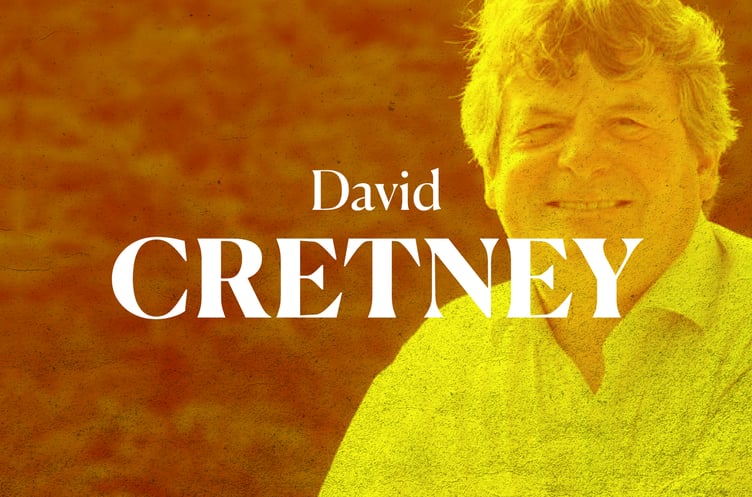This column first appeared in the Isle of Man Examiner of October 4.
There are some jobs which require commitment which by their very nature impacts on your day-to-day life.
Today I’m mentioning agriculture. I would be the first to admit a lack of knowledge overall in the subject.
However, it is very obvious that if, for example, your farming enterprise is one involving dairy cattle then your life fits in around the needs of the animals.
Much the same applies at lambing time. Any plans must be put on hold to support the sheep at this crucial time on top of the day-to-day care.
I’ve heard second hand about stories from long ago before mechanisation where on a farm that was five acres in the vicinity of the Clypse reservoir everything was done by hand. I’m sure that must have been the norm.
I heard also of a farmer who lived at Tate’s (Kate’s) Cottage in a big snow in the 1890s. He put sacks over his body with twine holding it all together got on the horse and went out with three dogs to gather the sheep in.
When he came back one of the dogs was gone.
Thanks to Arthur Christian for those snippets and I would love to hear of any other rural stories you may like to share whether stuff of legend from long ago or more recently… Please get in touch!
xxxxxxxxxxxxxxxxxxxxxxxxxxxxxxxxxxxxxxxxxxxxxxxxxxxxxx
It’s always nice to receive a letter.
Phillip Campbell who now lives in Lancashire contacted me following a recent piece here about spare coal being gathered up.
Aged about 10 he did the same with his younger brother.
They would stand by the quayside with an old pram to pick up the coal that fell while being loaded on to wagons pulled by horses. If spotted by the driver they were chased away!
The family lived on Market Hill above Pegram’s the grocers and opposite Lay’s the tailors.
He remembers the panic from people living in the terrace adjacent when the shop went on fire.
Phillip was a keen darts player, playing for the Clarendon then the Northern Lights who played out of the Wheatsheaf. When playing there they won the league seven years on the trot! Both pubs long gone.
He also played for the Ship Inn in Castletown, a sad sight today which is crying out to be redeveloped.
Phillip served in the RAF in Singapore at the same time as the sadly-missed character Terry Cringle but on different stations.
He remembers meeting up with Terry in Singapore a couple of times.
Thank you for your interesting memories Phillip – and all the best for your 88th birthday in November!
xxxxxxxxxxxxxxxxxxxxxxxxxxxxxxxxxxxxxxxxxxxxxxxxxxxxxx
A little while ago I mentioned about sweets either no longer available or which had changed over the years.
One of the most noticeable changes is the size of your favourite treat!
Others concern the name of a product. What was wrong with Marathon?
It changed to Peanut Marathon and for a long time now Snickers (what’s that all about?). Who remembers Terry’s Neapolitans at Christmas time in particular?
First produced in 1922 exotic flavours included Café au Lait, Mocha, Devon Milk, Plain Dessert, all of which disappeared when Kraft took over Terry’s in 2005.
How about Treets? They came in all chocolate, toffee or peanut.
They were marketed in the 1960s as the sweet that ‘melts in your mouth, not in your hand’.
They were discontinued in 1988. Chocolate Treets were replaced with Minstrels.
Peanut Treets were discontinued in favour of the multi-coloured Peanut M&Ms and toffee Treets were later sold as Relays before being dropped altogether.
Remember Opal Mints? They subsequently became Pacers in 1976 and turned from plain white chewy mints to have green peppermint stripes. A must for Celtic FC fans!
They were discontinued in 1985.
Sister brand Opal Fruits was introduced in 1960 and the name was changed in 1998 to Starburst.
Twenty-two years later Opal Fruits were relaunched in some stores as a ‘retro’ brand for a limited time – but still ‘made to make your mouth water’.
Cadbury’s is a favourite for many, with a particular history in Bournville near Birmingham. The founders of the business established back in 1824 selling tea, coffee and hot chocolate were forward-thinking by providing housing and social activities for their employees, which was rewarded with generations of loyalty.
Dairy Milk chocolate was introduced in 1905 and by 1914 was the company’s best selling product. Now owned by Mondelez International, Cadbury’s operates in 50 countries and is the second largest in the world after Mars.
Cadbury’s Dairy Milk remains a firm favourite!
However in that time lots of products have come and gone, here’s a few, can you remember any others? Mint Wispa, Peppermint Plain Chocolate, Strawberry, Time Out, Extra, Nux, Nut Crisp, Skippy, Aztec, Welcome, Spira, Bar six, Fuse, Oranges and Lemons, Old Jamaica, Gold Mine, Hazel, Nuts About Caramel, Astros, Snowflake, Dream, Taz, Tiffin, Milk Tray bar, Mint Crunchie, Orange Crunchie, Amazin Raisin, Marble, Touch Down, Countrystyle, Icebreaker, Rhumba… Let me know any other now-disappeared chocolate bars!
xxxxxxxxxxxxxxxxxxxxxxxxxxxxxxxxxxxxxxxxxxxxxxxxxxxxxx
I think there’s something special about all the seasons.
Each year as autumn approaches and the leaves begin to fall I look forward to reliving my youth and searching in special hidden places for conkers.
The shiny, jewel-like surface of the horse chestnuts lying among the leaf debris makes them easy to spot on the surface but often more are covered and require a more thorough search.
Usually some have landed in their green spiked coat and they are harvested as well.
Each year I pass the conkers on to individuals or places such as Pulrose playgroup.
They are then used as a teaching tool about the seasons, how they develop within the coat and for autumn display purposes.
Do they still have conker competitions at the Braaid Hall? Conkers were certainly a big thing at school where ingenious ways were thought up to make yours the hardest in preparation for battle!
On our island we boast and host a few ‘unusual’ events like the World Tin Bath Championship in Castletown, but did you know there is actually a World Conker Championship held annually since 1965 on the second Sunday in October in Northamptonshire?
Players from around the world enter the tournament, competing in a knock-out format in both team and individual formats, with titles for men’s, women’s and youth categories.
Up to 5,000 spectators watch around 400 players participating from many countries,including Australia, Austria, Canada, France, Japan, Mexico, New Zealand, Poland, Russia, South Africa, Sri Lanka, United States and United Kingdom.
The next autumn event for young people and witches on our island will be Hop tu Naa on October 31.
According to Culture Vannin, it is the oldest continuously existing tradition and described as the Manx equivalent of Hallowe’en, with some very important differences.
One of the key features is the ‘moot’ (turnip) which is hollowed out and decorated. There are a number of regional variations of Ginny the Witch sung by children in all sorts of different costumes from the traditional to the real scary!
There are a number of unusual customs and superstitions of Celtic origin.
A bit like the Vikings, witches tend to get a bit of a bad press but those I know are very nice people with a different perspective to which they are fully entitled.

.png?width=209&height=140&crop=209:145,smart&quality=75)


.png?width=209&height=140&crop=209:145,smart&quality=75)